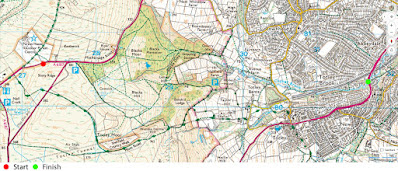 |
| An information board at Blacka Moor Nature Reserve |
10 days after a brief exploration of Old Edlington and New Edlington, to see the Grade I Listed St. Peter’s church and the early C20 settlement that grew around the Yorkshire Main Colliery respectively, my next day out began at Blacka Moor Nature Reserve on the outskirts of Sheffield.
Having spent an afternoon exploring the geology along Totley Brook earlier in the year, where I found various exposures of the Greenmoor Rock and the Grenoside Sandstone and I was therefore interested to see what I would find, when walking across the succession of strata from the Chatsworth Grit to the Greenmoor Rock and finishing at the Totley Rise Methodist Church on Abbeydale Road South – a distance of approximately 6.5 km.
Alighting from the No. 272 bus from Sheffield at the Hathersage Road/Access Road, I headed along the road towards the nature reserve and stopped to photograph a large block of gritstone, with an inscription that records this as the site of the Stonyridge Toll Bar, which closed in 1884.
Taking the path through Strawberry Lee Plantation, which is set on the Chatsworth Grit, I soon came across a spring, which presumably rises at the junction with the underlying impermeable mudstones of the Marsden Formation and forms one of the streams that feeds Blacka Dyke.
 |
| A spring in Strawberry Lee Plantation |
Leaving the plantation, I had a view of the rough grass and heather covered moorland that is a dominant feature of the Eastern Moors to the south-west of Sheffield, which fall within the boundary of the Peak District National Park.
Following one of the marked public footpaths for a short distance, a change in the vegetation marks where the land becomes quite boggy. Although dry at the time of my visit, the path here is paved with flaggy sandstone with ripple marks, to form a causeway.
Leaving the causeway and continuing along the rough unmade path, I was surprised to discover that the surrounding area was covered by bilberry bushes, which had an abundance of ripe fruit and made me wish that I had a suitable container to collect some – as I discovered a Polish couple were doing a bit further along the path.
Except for a slab of grey silty sandstone, which is typical of the Coal Measures and I think may be waste stone from the laying of the causeway, I hadn’t seen any rocks but, as I continued along the well worn path, I encountered many lumps of gritty sandstone sticking out of the sandy soil.
Looking more closely at these, the abundance of fingernail sized white quartz pebbles immediately informed me that I was looking at detached fragments of the underlying Chatsworth Grit; however, although I had seen this rock formation in many places along the gritstone edges and the Rivelin Valley, I had never seen it with such a well developed grey patina.
As a geologist, when I am on a walk where I think that I might find an outcrop of rock, I always take my Estwing hammer with me and I cracked open a couple of small weathered pieces that revealed a brightly coloured interior – with the one that I kept being distinctly reddened.
 |
| Weathered specimens of Chatsworth Grit |
For some while, I had wanted a piece of pebbly Chatsworth Grit to add to my rock collection, but it is quite difficult to obtain a piece from outcrops of this rock formation, which are generally quite rounded in profile. This gritstone contains quite a high feldspar content, which is often very weathered in the smaller detached blocks so, on this occasion, I simply prised a large lump out of the ground on the side of the path and put it it in my rucksack.
As I continued along the path, before beginning the descent down towards Totley, I came across a very large flat boulder of Chatsworth Grit that was partially obscured by the dense growth of bracken. One of the features of the Eastern Moors, in addition to the spectacular gritstone edges, is these erosional remnants, which sometmes form small tors.










No comments:
Post a Comment